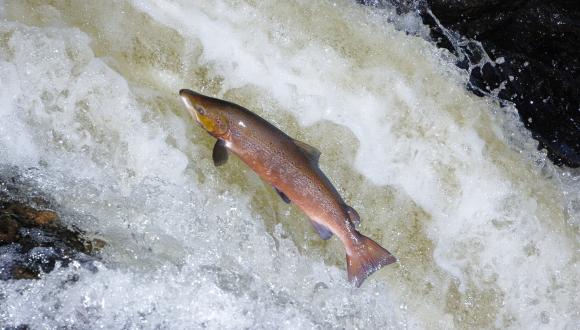Brown trout
The brown trout is one of Scotland’s most recognisable native fish – and one of Europe’s most widespread freshwater fish.
The native range of the brown trout (Salmo trutta) stretches from Iceland and the White Sea in the north to Morocco’s Atlas mountains in the south.
In Scotland, brown trout are found in:
- rivers
- large lochs
- upland lochans
This species has two possible life-cycle patterns. While brown trout are purely freshwater-resident, ‘sea trout’ migrate to the sea to feed and mature. Some Scottish rivers are home only to brown trout populations. Other rivers may have populations of brown trout and sea trout.
Most brown trout populations also undertake significant migrations – though always staying in freshwater. Juvenile fish may migrate from nursery areas to lochs, where they may remain until adulthood. Migrations may also occur between feeding areas in the summer months.
Brown trout are polymorphic and many morphotypes exist across Scotland. Most important are the original colonisers, which took to isolated lochs and streams after the last ice age. Brown trout populations that have remained isolated ever since, like ‘ferox’ (a piscivorous form), are of considerable conservation value.
Sea trout life-cycle
Sea trout are native to Scotland and are found widely in Scandinavia, Iceland and the Baltic region. They can be found in many other parts of the European Atlantic seaboard – even as far south as Portugal.
Like Atlantic salmon, sea trout migrate to the sea to feed and grow before returning to freshwater to spawn. But while Atlantic salmon travel to far-off feeding grounds, sea trout stay in coastal areas.
Juvenile sea trout spend time in freshwater before physiological changes occur that let them migrate to sea as ‘smolts’. Many populations reach the smolt stage after two years, though it can take longer in some locations.
Female trout are more likely than males to become smolts and migrate to sea. Like salmon, migration downstream to the sea usually takes place from April to early June.
How long fish spend at sea varies greatly between individuals and populations. Some small fish (‘finnock’) return to the river between July and September, after just a few weeks or months at sea. But many adults return as larger ‘maiden’ fish, after 12 months or more at sea.
Sea trout spawn in the river where they were born, from mid-October to early January. Female fish lay their eggs in gravel depressions known as ‘redds’. As a female releases her eggs, an adult male immediately fertilises them. The female then covers the fertilised eggs with gravel.
The young trout will emerge from the gravel between mid-March and early May. Many of the spent adults, known as ‘kelts’, will die. But a significant number will survive and return to the sea to recover and grow. A sea trout can spawn up to 13 times in its lifetime.
Protection of trout
Neither form of trout receives much protection within conservation legislation. Some protection exists in the form of exploitation controls exist within fisheries legislation. Sea trout are further protected within fisheries acts to do with the protection of ‘salmon’.
But both brown trout and sea trout are UK Biodiversity Action Plan priority fish species.
Find out more
Read our guidance for planners and developers on protected animals.




